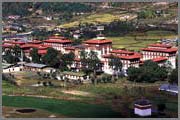
| Tashicho Dzong.
Tashicho Dzong, houses the Seat of Government in Thimphu. The Tshogdu, as the National
Assembly is known, meets here on a regular basis. It consists of approximately 150
members, some elected by the people, some elected by the Clergy, and some appointed by
the King. With the Tashicho nestled in a narrow valley, it is easy to see how Bhutan
could be envisioned as an archetype of the famed Shangri-La.
|
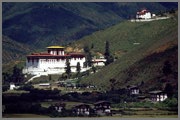
| Watchtower.
Paro, the most beautiful of all Bhutan's valleys, houses the historic Paro Dzong. The
first monastery was built here in the tenth century, and was subsequently rebuilt several
times over the centuries. It served as an effective defence against numerous invasion
attempts by the Tibetans. On the hill above the Dzong, stands an ancient watchtower which
has been, since 1967, the National Museum of Bhutan.
|
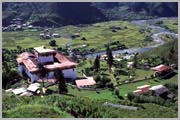
| Paro Valley.
Looking down from the watchtower, one can see the beauty of the Paro Valley. This, believe
it or not, is the big city. Paro has the country's major airport, with a paved runway
actually big enough to land a Twin Otter sized aircraft.
|
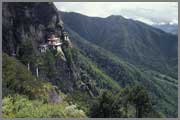
| Taktsang.
Like an outgrowth of the terrain itself, the gem-like Taktsang Monastery clings to a
sheer, 3000 foot rock face. The name of this gravity-defying cluster of buildings means
literally "The Tiger's Nest", an allusion to the popular legend that Padma Sambhava flew
here from Tibet on the back of a tiger. Requiring several hours of hiking up a narrow
twisting trail to reach it, the journey is well rewarded.
|
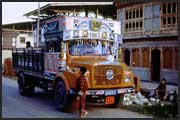
| Colourful Bus.
There are few roads in Bhutan. Most of the major cities have interconnecting roads - but
all smaller villages are accessible only by footpaths. With high mountain ranges seperating
the villages, it can take many days to travel to the village in the next valley. The public
transportation system of buses and trucks are often colourfully decorated.
|
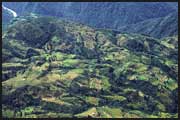
| Terraced Fields.
There is probably no country of Bhutan's size which contains within its borders a greater
spectrum of agricultural and climatic conditions. Here rice grows at altitudes as high as
8,100 feet, subtropical fruit trees flourish within sight of the perpetual snows of the
Great Himalaya, animals graze in lush pastoral valleys at the foot of barren, rocky
mountains. It is a fascinating, often startling panorama. The crops vary from rice, maize,
wheat, barley and potatoes to pineapples, bananas, litchis, mangoes & guavas.
|
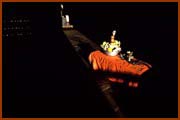
| Alter.
The state religion of Bhutan is the Drukpa sect of Kagyupa, a branch of Mahayana Buddhism.
Throughout Bhutan, from the most densely populated valleys to the most remote mountain
waystop, religious monuments and symbols bear witness to a deep and respected faith. Prayer
wheels turn, prayer flags wave in the breeze, sending the message of Buddhism forth on the
winds, and even on lonely alpine passes the sacred mantra Om Mani Padme Hum is found,
carved on slabs of stone and rocky hillsides. Every Bhutanese home has a chapel where the
family prays each day before the altar.
|
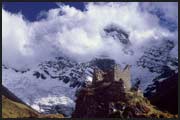
| Chomolhari.
Chomolhari, abode of the goddess whose name it bears, stands in the Southwest, marking
the border with Tibet's Chumbi Valley. Four passes, three in the west and one in the east,
were once the most important gateways to Tibet. Today they are all but deserted, and at
the foot of Chomolhari, the ruins of an ancient fortress and watchtower stand in mute
testimony to the activity which once took place at this now lonely frontier.
|








